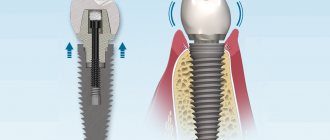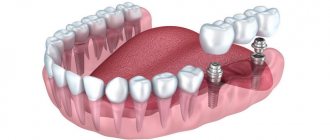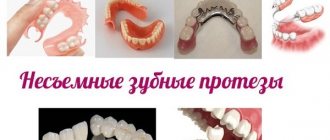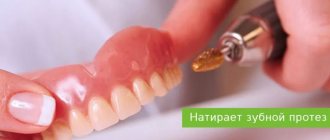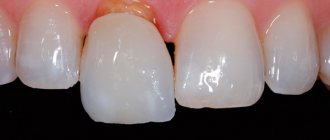Why the bridge prosthesis is loose in the mouth - the reasons for mobility and how to deal with them
Article navigation
- Causes of instability
- When not to build a bridge
- Diagnostics
- Remove the movable prosthesis
- Prosthetics provided that the supports are intact
- Prosthetics, if supports have to be removed
- Strengthen the bridge yourself
- How long can a prosthesis last?
- When is the best time to replace a bridge?
question to a specialist
When a dental bridge becomes loose, a person involuntarily asks questions - is this normal and what to do? Looking ahead, let's say that this is not the norm, and delaying the correction of the situation can lead to complications. Why a dental bridge can wobble immediately after installation, after several months or years, whether it can be strengthened and how to do it correctly, read in the following material.
Causes of structural instability
If the dental bridge is wobbly immediately after installation, then there may be 2 options - either a full diagnosis was not carried out (and the bridge could not be installed at all), or prosthetics1 occurred due to errors on the part of the doctor. Considering the last option, we can highlight the following reasons why a dental bridge becomes loose:
- There is a gap inside between the crowns and supporting teeth: it was formed due to errors - when taking impressions (molds) or when making a prosthesis in the laboratory,
- poor-quality cement composition on which the prosthesis rests,
- improper filling of canals or aseptic treatment of supports: because of this, caries began under the crowns,
- incorrect turning of the supports: ideally they should look like cylinders or “stumps”, but not like cones or “herringbones”,
- crack in the structure
- the screw connecting the bridge to the implant (more precisely, to the abutment on the implant) is loosely tightened.
A natural reason where “no one is to blame” is the end of the service life of the bridge and cement composition (we’ll talk about this in more detail below). One possible reason for a loose dental bridge could be an injury to the face or jaw.
Preliminary consultation and treatment planning
After the patient and specialist determine the type of prosthesis that will be installed, they begin to select the material used for its manufacture.
The most common and popular are metal-ceramic prostheses. You can also make a prosthesis from metal, porcelain or gold. Zirconium ceramics and aluminum oxide are also popular and very durable.
Let's look at the stages of installing dental bridges:
- Examination of teeth and jaw.
- If necessary, treatment of teeth and gums is performed.
- Introduction of anesthesia.
- Preparation of supporting teeth (most often grinding them).
- Casts and x-rays of the opposite row of teeth, as well as supporting teeth.
- Making a model of a prosthesis from plaster and trying it on.
- Choice of crown color. At this stage it is excellent to work with ceramics, since this material allows you to choose the most suitable shade of color.
- Creating a temporary bridge that will protect the teeth from external irritants before making a permanent one.
- Making a permanent bridge.
- Installation and cementation of the prosthesis.
In what cases should you not install a bridge?
To avoid questions about why a dental bridge is loose and what to do if it becomes mobile, you need to know about the contraindications specifically for this type of prosthesis. It is clear that if there are no outer teeth in a row or there are no more than 4 teeth in a row, then it will not be possible to install a bridge. But there are also hidden or unknown to the patient pathologies - contraindications. They can only be detected with careful preparation for treatment - we add that this is the responsibility of the dentist. But some specialists neglect diagnosis, and as a result the patient suffers.
Conditions when bridge prosthetics on natural supporting teeth are prohibited are as follows:
- atrophy or “subsidence” of the bone in the area of support: atrophy will continue further, while the gums will begin to recede, and the tooth necks and roots will be exposed. Therefore, there is a risk of inflammation or caries; the supports themselves may begin to wobble, because lose fixation in the bone,
- inflammation and bleeding of gums,
- late stages of periodontitis and periodontal disease (these pathologies are easily diagnosed): a whole range of problems is observed here - bone atrophy, inflammation and decrease in the level of gums, tooth mobility,
- “undetected” pulpitis or periodontitis in supporting units: the dentist did not remove the “dental nerve” - depulpation (although now doctors always try to do this before prosthetics),
- the presence of cysts and granulomas under the roots,
- cracks in the roots
- poor canal filling during previous treatment (and the doctor did not notice this),
- malocclusion,
- bruxism and increased tone of the masticatory muscles.
The implant fell out, what should I do?
In rare cases, the implant becomes unscrewed from the bone and may fall out. This occurs when the size of the socket and the intraosseous element do not match, as well as due to the weakness of the jaw bone. Such situations, when the implant loses its fixation and falls out, but there is no inflammation or other signs of rejection, can occur against the background of systemic diseases in which tissue regeneration is impaired (osteoporosis, diabetes mellitus). The problem is solved by reinstalling the structure using regenerative membranes (enriched with growth factors) that accelerate osseointegration, and prescribing a course of vitamin therapy.
How is diagnostics carried out?
What to do if the dental bridge starts to loosen? Or if it wobbles, but only on one side? In general, if the instability of a bridge is detected, as well as before prosthetics in general, it is imperative to undergo an examination. Often the first step is X-ray diagnostics - and optimally, if this is a computed tomography (CT) scan of the jaw. Because ordinary spot and panoramic images produce a “flat picture” on one side, but CT is a three-dimensional image from all sides. Those. It is almost impossible not to notice any pathological process using tomography.
The dentist also visually and with the help of instruments assesses the condition of the oral cavity, the mobility of the prosthesis - sometimes the structure can “fly off” from the supports even during the examination. The patient is asked about associated symptoms and their duration - pain, bleeding, unpleasant odor from under the crowns, etc.
How to remove a movable prosthesis, and what will happen to it next
What does a dentist do when a bridge becomes loose? Here, further treatment tactics can be “suggested” by an x-ray examination. But, as a rule, the bridge has to be removed. Removal is carried out using an ultrasonic scaler (which crumbles the cement inside). Crown and bridge removers are also used - for example, a Kopp apparatus or an automatic micromotor Anthogyr Safe Relax with strings (cables) and hooks. Once the deficiencies are corrected, the old prosthesis can be fixed back in place.
If it is impossible to remove the bridge without damage, the doctor will use special scissors or crown-cutting forceps - after which a new prosthesis will need to be made.
Prosthetics provided that the supports are intact
After the bridge is removed, the condition of the supporting teeth and gums is examined and, if necessary, treatment is carried out (carious tissue is removed, the canals are re-filled, a new pin or stump inlay is placed). Since the relief and dimensions of the support often change during the treatment process, impressions have to be taken again and a new bridge made.
The old bridge can be put back if, for example, the problem was low-quality or old cement - which will be removed from the product, and then the prosthesis will be fixed with fresh and high-quality adhesive. If the service life of the prosthesis has already come to an end and it has cracks, severe abrasions, or chips, a new one needs to be made.
Question answer
Hello! For 8 years I have had a metal-ceramic bridge of three crowns supported by teeth 15 and 13 (13 has a pin). Recently it began to wobble; apparently the pin on the 13th tooth had become uncemented. Is it possible to remove it, cement it and put it back or is it better not to risk the supporting teeth? And how long can you go on like this? So far it is only slightly wobbly. Regards, Alexey!
Hello! The upper tooth (six) felt like it had fallen through - it was warped (the number five was removed) and destroyed the lower tooth (in half). Is there anything that can be fixed? Vladimir
orthopedic dentist, chief doctor of “Zub.ru” on Voikovskaya Savinov Denis Viktorovich Dentistry Zub.ru on Voikovskaya metro station
Good afternoon At the end of 2006 I had dental prosthetics done. The bridge was fixed with a paw with a healthy tooth. At the end of 2010, this tooth was treated. A hole has formed under the paw. The bridge was movable. After removing the foot and fixing the bridge, 3 months later in the area of the crown, the tongue is stabbed from the inside with something sharp. Tell me, please, what to do? Nina Nikolaevna
Prosthetics, if supports have to be removed
Very often, over years of increased stress, the supporting teeth are so destroyed that they have to be removed along with the roots. They can also collapse even after a few months or a couple of years - if there were any undetected diseases before prosthetics (this has already been discussed above). Or, if the patient did not see a doctor for a long time, he endured unsteadiness and pain. After removal, you will need to install either a longer bridge and “prepare” new supports for it, or a removable denture.
“I had a metal-ceramic bridge installed on my front teeth a couple of years ago, but then suddenly it began to wobble. At first I didn’t attach much importance to it. Maybe it seemed like a little. But he staggered more and more, and his tooth began to ache. I went to the dentist. The verdict is to remove the tooth, there is a large cyst. I don’t understand where it came from.”
Stanislav, review from otzovik.com
But the best option is implantation. This way, it will be possible to preserve the remaining living teeth (and not use them for supports) and extend the service life of the new orthopedic structure. After all, dentures on implants last approximately 2 times longer than those installed on natural teeth.
Read on the topic: dental bridge on implants - what it is and who it is suitable for.
Installation of metal-ceramic dental bridges
Stage 1 - consultation.
During the first visit to the doctor, anamnesis is collected and the rehabilitation method is agreed upon.
Stage 2 - rehabilitation.
Preparation of the oral cavity, treatment of concomitant dental diseases, if any.
Stage 3 - production of the prosthesis.
Computer modeling is considered the most advanced and most accurate method for manufacturing orthopedic structures. In the case of metal ceramics, a metal frame is first made, and after applying the ceramics, the product is fired.
Stage 4 - implantation.
If the product is fixed on implants, a surgical stage is necessary. A classic denture requires grinding of adjacent teeth.
Stage 5 - installation.
Fitting and installation of the finished structure.
Is it possible to strengthen the bridge yourself?
How and with what to fix a loose dental bridge yourself at home? Here, even if it seems that you can glue it with something for a while (while you are waiting for a dentist appointment, for example), then you should not do this. Neither glue nor chewing gum will help here - but will only harm. After all, a chemical burn of the gums or supporting teeth may begin. You can irreparably damage the material of an orthopedic structure - metal ceramics, ceramics, plastic, ceramic composite, metal, zirconium dioxide.
What to do then? It is better to simply reduce the load on the part of the jaw where the wobbly bridge is located, and rinse your mouth after every meal to remove plaque and bacteria. It is better to avoid using an electric toothbrush and eating hard and viscous foods (lumpy meat, taffy). And be sure to make an appointment with the dentist.
Advantages and disadvantages
Installing bridges is very popular in the modern world and has many advantages:
- The ability to correct visible defects and make your smile perfect.
- Despite the lightness of the structure, its material is very strong.
- Bridges do not cause discomfort (if all care rules are followed).
- Made from the latest materials.
- Ideal for replacing a lost tooth or several teeth at once.
- A quick process of installation and removal, as well as quick adaptation to the prosthesis.
- Easy to care for.
- No special specialist training is required. Installation can be done in any clinic.
- The cost is not high compared to implants, while bridges are practically not inferior to them in reliability.
Installing the structure, in addition to its advantages, also has disadvantages:
- The need to grind down the supporting teeth to install a bridge (you can also use a more expensive and less reliable method - adhesive prosthetics).
- For fastening, you must have your own living teeth or use implants.
- Possible atrophy of the jaw tissue under the bridge.
- There is a strong load on the supporting teeth, which can cause them to move.
How long can a bridge last?
The average lifespan of a bridge on natural teeth is 5 years. With good care and, what is very important, high-quality manufacturing from the beginning, it can last 7-10 years. Bridges on implants last longer - here 10 years is the minimum period, on average they last 15 years. If we consider zirconium dioxide prostheses on implants, they will last 15-25 years or more. Then they can be replaced, without changing implants.
Don't know what type of prosthetics to choose?
We will help in the selection, advise where to read more information and compare types of prosthetics.
Consultation with an orthopedic doctor in Moscow clinics is free! Call now or request a call
Working hours: from 9:00 to 21:00 - seven days a week
Conditionally removable prosthetics
As mentioned above, doctors in many dentistry places only permanent bridges on teeth, which means that it is technically impossible to get the structure if desired. However, there is another option for mounting the installation. This is the same prosthesis, only with a single intermediate part. Instead of crowns, fasteners-locks are mounted.
The solution is suitable for both artificial and natural units preserved in the oral cavity. In this case, the enamel is not affected, and the elements can be removed painlessly.
When is it better to replace a bridge or crown?
If mobility of the entire bridge, some part of it, or a separate crown appears, then the best option for what to do next is to immediately contact an orthopedic dentist. Of course, the patient’s desire to keep the old prosthesis and continue to walk with it is understandable. But it is not always possible to save the orthopedic structure.
When should a crown or bridge be replaced? While a small chip of ceramics can be “repaired”, large chips or cracks are difficult to restore – so the doctor suggests a replacement. If 1-2 crowns fall off, if you are allergic to the material, you will have to make a replacement. You will also have to make a new prosthesis if the support was drilled, the stump tab or pin was changed, or if teeth were removed.
1Markskors R. Fixed dental restorations, 2007.
QUESTION ANSWER
QUESTION Tell me, if the bridge is wobbly on only one side, as if it moves a little when chewing, then what should I do to secure it? Anatoly
ANSWER Hello, Anatoly. You don’t need to do anything yourself, since there may be inflammation inside under the prosthesis - and if treatment is delayed, it will only get worse. Therefore, the best option is to visit an orthopedic dentist. Preferably the one from which you installed the bridge earlier. The doctor will conduct a full examination and take an x-ray. And it will already become clear whether it is possible to “plant” the old bridge with fresh cement or whether a new bridge will have to be made (because the old one could have been manufactured with violations).
What if the structure hasn’t fallen out, but is already wobbly?
In this case, this may indicate that either secondary caries has formed under the bridge, or a violation of the integrity of the adhesive cement structure has occurred.
In any of these cases, it is impossible to somehow influence the situation on your own; only a doctor will be able to determine the true cause of the problem and eliminate it. This may require repositioning the dental bridge.
You can suspect that you have a problem not only by increased mobility of the orthopedic structure, but also by some other symptoms:
- Pain in one of the supporting teeth.
- Inflammation and pain in the gum area located directly under the bridge.
- Bleeding from the adjacent gums.
Over time, ceramic dentures can develop abrasions and chips. Such defects can be eliminated using dental restoration of the surface of the orthopedic structure directly in the patient’s mouth. Dental bridges made of metal-plastic, ceramic, plastic and metal-ceramics are subject to such restoration.
